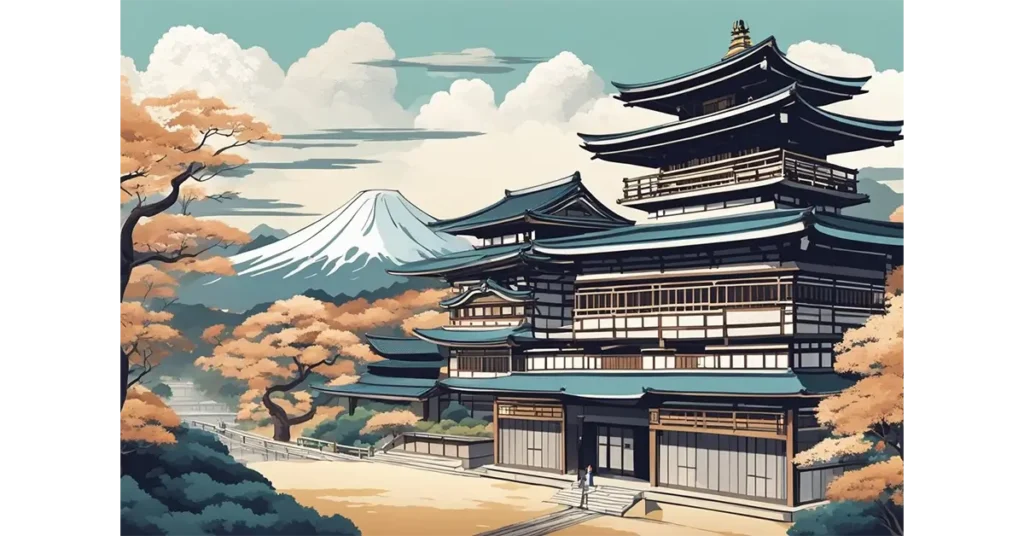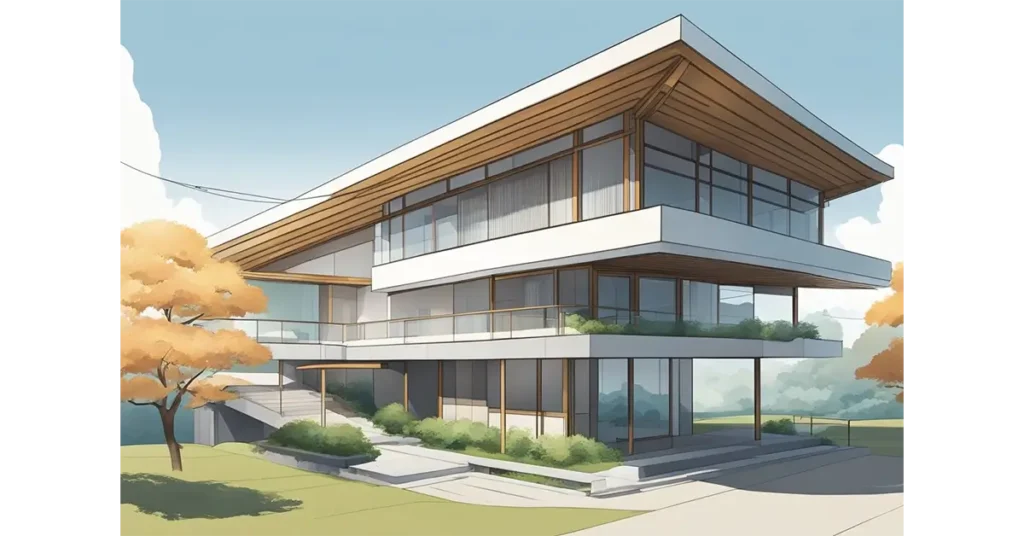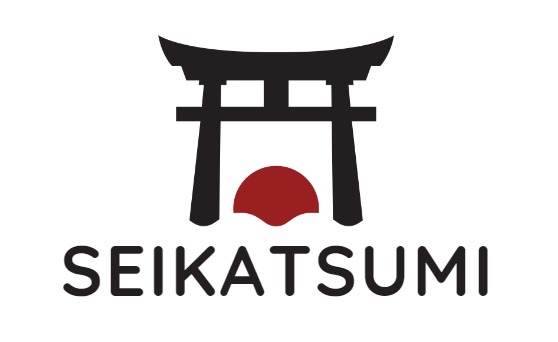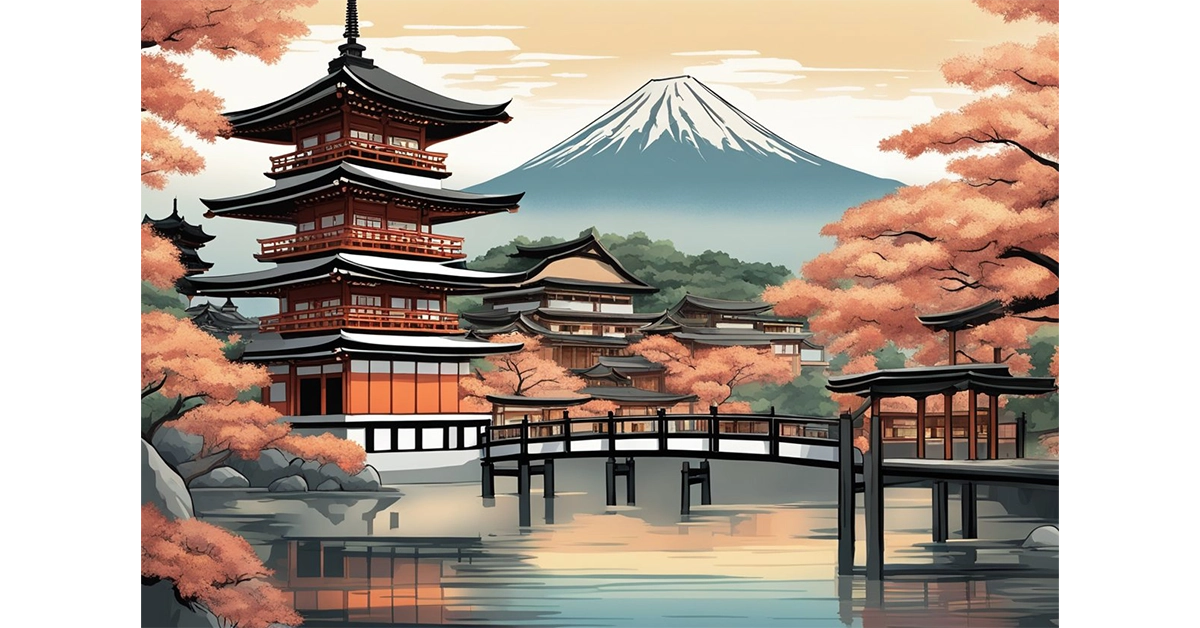When it comes to architecture, Japan is a country that has a lot to offer. Japan famous architecture: from ancient shrines and temples to modern skyscrapers, Japan’s architecture is as diverse as it is impressive. In this article, we will take a closer look at some of Japan most famous architecture, exploring the history and significance of each structure!
Not interested in historical background?
No worries, we got you! Skip the historic part and thrive straight into Japan famous architecture with its Top 10 MOST ICONIC Buildings. All you have to do is press this button:
-> SKIP RIGHT INTO OUR TOP TEN <-
Historical Overview of Japanese Architecture
Japanese architecture has a rich and ancient history that spans thousands of years. It has been influenced by various cultures, including China and Korea, but has developed its unique style and characteristics. Japanese architecture is known for its simplicity, harmony with nature, and attention to detail. In this section, we will provide an overview of the historical development of Japanese architecture.
Prehistoric Period
The earliest known Japanese architecture dates back to the Jomon period (14,000 BC – 300 BC). During this time, the Japanese people lived in pit dwellings and made use of natural materials such as wood, bamboo, and clay. The pit dwellings were simple structures made by digging a hole in the ground and covering it with a thatched roof.
Asuka and Nara Periods
During the Asuka and Nara periods, Japan was heavily influenced by Chinese culture and architecture. This period saw the construction of the first Buddhist temples and shrines in Japan, such as the Todai-ji temple in Nara. The buildings were constructed using wood and featured a symmetrical design with a central axis.
Heian Period
The Heian period saw the development of the distinct Japanese architectural style known as Wayo. Wayo architecture is characterized by its use of natural materials, such as wood and paper, and its attention to detail. The period saw the construction of the first shinden-zukuri style palaces, which were heavily influenced by Chinese Tang dynasty architecture.
Kamakura and Muromachi Periods
The Kamakura and Muromachi periods saw the development of the Zen Buddhist sect in Japan, which had a significant impact on Japanese architecture. Zen temples were constructed using natural materials and featured a simple, unadorned design. The period also saw the development of the tea ceremony, which led to the construction of tea houses and the development of the sukiya-zukuri style of architecture.
Edo Period
The Edo period saw a significant increase in urbanization and the construction of large-scale buildings such as castles and temples. The period also saw the development of the unique Japanese architectural style known as Edo-zukuri, which features a steeply sloping roof and a distinctive curved eave.
Overall, Japanese architecture has a rich and diverse history that has been influenced by various cultures and traditions. Its unique style and attention to detail have made it famous around the world.
Top 10 Japan Famous Architecture

If you are planning to visit Japan, you should not miss the opportunity to see some of the most Japan famous architecture in the world!. Japan is known for its unique and innovative architecture that blends modernity with tradition.
In this section, we will introduce you to the MUST SEE Top 10 Japan famous architecture!
Himeji Castle

Himeji Castle is a UNESCO World Heritage Site located in Himeji city, Hyogo Prefecture. It is considered one of the finest surviving examples of Japanese castle architecture. The castle’s white walls and elegant design have earned it the nickname “White Heron Castle.” It is a must-visit destination for anyone interested in Japanese history and architecture.
Kinkaku-ji (Golden Pavilion)

Kinkaku-ji, also known as the Golden Pavilion, is a Zen Buddhist temple located in Kyoto. The temple is famous for its stunning golden exterior, which reflects on a pond that surrounds it. The temple was originally built in the 14th century and has been rebuilt several times. It is a popular destination for tourists and locals alike.
Tokyo Tower

Tokyo Tower is a communications and observation tower located in the heart of Tokyo. It is the second-tallest structure in Japan and is a popular tourist attraction. The tower’s design is inspired by the Eiffel Tower in Paris and is a symbol of Tokyo’s modernity.
Kyoto Imperial Palace

The Kyoto Imperial Palace is a former residence of the Emperor of Japan. It is located in the heart of Kyoto and is a popular tourist attraction. The palace’s architecture is a blend of traditional Japanese and Chinese styles. Visitors can take a guided tour of the palace and learn about its history and architecture.
Tokyo Skytree

The Tokyo Skytree is a broadcasting and observation tower located in Tokyo. It is the tallest structure in Japan and the second-tallest structure in the world. The tower’s design is inspired by traditional Japanese architecture and is a symbol of Japan’s modernity.
Itsukushima Shrine

Itsukushima Shrine is a Shinto shrine located on the island of Miyajima in Hiroshima Prefecture. The shrine is famous for its torii gate, which appears to be floating on the water during high tide. The shrine’s architecture is a blend of traditional Japanese and Chinese styles.
Osaka Castle

Osaka Castle is located in Osaka. The castle was built in the 16th century and has been rebuilt several times. The castle’s architecture is a blend of traditional Japanese and Western styles. Visitors can take a guided tour of the castle and learn about its history and architecture.
Tōdai-ji

Tōdai-ji is a Buddhist temple located in Nara. The temple is famous for its Daibutsu (Great Buddha) statue, which is one of the largest bronze statues in the world. The temple’s architecture is a blend of traditional Japanese and Chinese styles.
Nagoya Castle

Nagoya Castle is a famous castle located in Nagoya. The castle was built in the 17th century and has been rebuilt several times. The castle’s architecture is a blend of traditional Japanese and Western styles. Visitors can take a guided tour of the castle and learn about its history and architecture.
Fushimi Inari Taisha

Fushimi Inari Taisha is a Shinto shrine located in Kyoto. The shrine is famous for its thousands of torii gates that form a pathway up the mountain. The shrine’s architecture is a blend of traditional Japanese and Chinese styles.
These are our top picks for famous architecture sites in Japan. Each of these sites offers a unique glimpse into Japan’s rich history and culture. We hope you enjoy your visit to these amazing destinations!
If you have already been there or plan to visit these spots, let us know in the comments how you liked it!
Traditional Japanese Architecture

When we think of Japan, one of the first things that come to mind is the country’s famous architecture. Traditional Japanese architecture is characterized by its extensive use of wood and the integration of nature into the design. It has been influenced by various factors, including religion, climate, and culture.
One of the most famous examples of traditional Japanese architecture is the Shinto shrine. These shrines are typically made of wood and feature a distinct curved roof. The roof is designed to mimic the shape of a bird’s wings and is meant to symbolize the connection between heaven and earth.
Another famous example of traditional Japanese architecture is the Buddhist temple. These temples are often built on hills or mountains and feature a pagoda, which is a tower-like structure with multiple levels. The pagoda is meant to symbolize the journey to enlightenment and is often adorned with intricate carvings and decorations.
In addition to shrines and temples, traditional Japanese architecture also includes residential buildings, such as the minka and machiya. The minka is a traditional farmhouse that is often found in rural areas. It features a thatched roof and an open floor plan, with sliding doors and screens used to divide the space. The machiya, on the other hand, is a traditional townhouse found in urban areas. It features a narrow frontage and a deep interior, with a courtyard in the center.
Modern Japanese Architecture

Japan is known for its unique and innovative architecture, blending traditional design elements with modern technology and materials. The country has produced some of the most iconic and awe-inspiring buildings of the 21st century, earning a reputation as a leader in contemporary architecture.
One of the most famous modern Japanese architects is Tadao Ando, whose minimalist designs have won numerous awards and accolades. His buildings often feature clean lines, geometric shapes, and a focus on natural light and materials. Some of his most notable works include the Church of the Light in Osaka and the Chichu Art Museum in Naoshima.
Another prominent figure in modern Japanese architecture is Kazuyo Sejima, who co-founded the firm SANAA. Her designs are characterized by their simplicity and elegance, with a focus on creating spaces that feel open and inviting. Some of her most well-known projects include the Glass Pavilion at the Toledo Museum of Art and the 21st Century Museum of Contemporary Art in Kanazawa.
Other notable architects and firms in Japan include Kengo Kuma, who designed the stunning National Stadium for the 2020 Tokyo Olympics, and Shigeru Ban, who is known for his innovative use of sustainable and recyclable materials.
Influence of Japanese Architecture on the World
Japanese architecture has been a source of inspiration for architects around the world. Its unique blend of simplicity, elegance, and functionality has influenced many architectural styles, from modernist to postmodernist.
One of the most significant contributions of Japanese architecture to the world is the concept of harmony with nature. Japanese architects have always sought to create buildings that blend seamlessly with their surroundings, using natural materials such as wood and stone, and incorporating elements such as gardens and water features.
Another important influence of Japanese architecture is the emphasis on minimalism and simplicity. Japanese architects have always preferred clean lines and uncluttered spaces, which has influenced modernist and postmodernist architects around the world.
The use of traditional Japanese building techniques has also influenced architects around the world. For example, the use of interlocking wooden joints, which eliminates the need for nails or screws, has been adopted by architects in Europe and North America.
In addition, the aesthetic principles of Japanese architecture, such as asymmetry, simplicity, and the use of natural materials, have influenced many other design fields, including fashion, graphic design, and product design.
Our Opinion on Japan Famous Architecture
Japan’s architecture is a captivating fusion of tradition and innovation, seamlessly blending ancient elements with modern designs. Take the Tokyo Skytree, for instance, Japan’s tallest building, drawing inspiration from traditional pagoda architecture. This integration not only enhances the building’s aesthetics but also bolsters its earthquake resistance.
What sets Japanese architecture apart is its commitment to harmonizing with the natural surroundings. The Katsura Imperial Villa in Kyoto exemplifies this ethos, integrating seamlessly with its surrounding gardens to create a tranquil haven.
Equally commendable is Japan’s emphasis on functionality in architectural design. The Tokyo International Forum, a versatile convention center, stands as a testament to Japanese architects’ meticulous attention to detail. Its flexible interior design caters to a myriad of events, showcasing the marriage of beauty and practicality.
In essence, Japan’s architectural marvels not only reflect a deep respect for tradition and nature but also highlight a remarkable ability to create spaces that are both visually appealing and highly functional.
The Japan famous architecture is a testament to the country’s rich cultural heritage and innovative spirit. From ancient temples to modern skyscrapers, Japan’s architecture is truly awe-inspiring and deserves to be celebrated.
Did you like the article? You might also be interested in our article about modern art in Japan and our article about Japans beautiful nature. Just Click me!
Frequently Asked Questions
What is the biggest Building in Japan?
The biggest building in Japan is the Abeno Harukas skyscraper, which stands at 300 meters tall and has 62 floors. It is located in Osaka and was completed in 2014. The building is a mixed-use development that includes a department store, offices, a hotel, and an observation deck on the top floor.
What is the oldest Building in Japan?
The oldest building in Japan is the Horyu-ji temple in Nara, which was built in the 7th century. The temple complex includes several buildings, including the main hall, pagoda, and lecture hall. The buildings are considered to be some of the oldest surviving wooden structures in the world and are designated as a UNESCO World Heritage site.
How does traditional Japanese culture impact the design of famous architectural sites?
Traditional Japanese culture has a significant impact on the design of famous architectural sites in Japan. Many buildings incorporate elements of Japanese aesthetics, such as simplicity, harmony, and natural materials. For example, the design of traditional Japanese houses emphasizes the relationship between interior and exterior spaces, with sliding doors and screens that can be opened to create a seamless connection with nature. Modern Japanese architects have also drawn inspiration from traditional Japanese design principles, creating buildings that blend traditional and contemporary styles.
The places mentioned above are definitely must-sees for us and we recommend them to anyone planning a trip to Japan!
Let us know in the comments what you think of our suggestions for Japan famous architecture!



